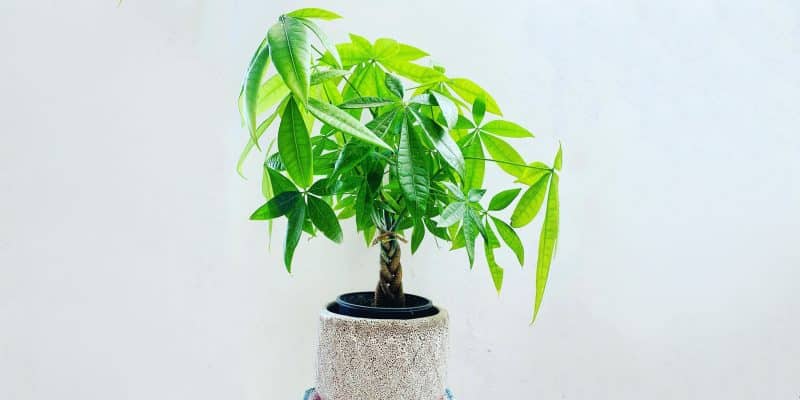If you’re on the hunt for an interesting houseplant that can add a touch of luck to your space, Pachira aquatica, also known as the money tree, might be just the one.
Money tree plants are very beginner-friendly. Plus, put it in a small container and braid its stems into a miniature tree, and you’ve got a bonsai with a tropical vibe!
Let’s dive into all the basics about money tree plant care so you can start bringing a little bit of that green (are we talking about shiny green leaves here? Moola? Who knows!) into your own space.
Table of Contents
Money Tree Care Guide
History, habitat, and characteristics
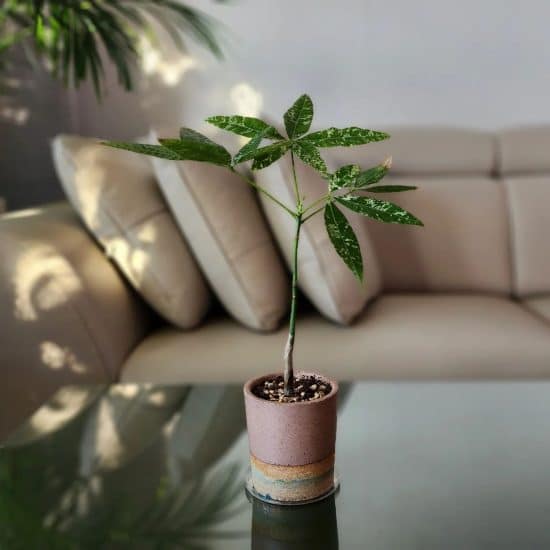
The Money Tree (Pachira aquatica), is native to the freshwater swamps and tropical rainforests of Central and South America. Pachira is native Guyanese (hence Guiana Chestnut), and aquatica is Latin for “aquatic,” or “growing near or in water.” But does it . . . grow money?
The lore surrounding the money tree is tied to a Taiwanese legend of a man who prayed for wealth and then stumbled upon the first money plant in the forest. He sold the cuttings and became rich from the profits!
Money tree plants hold significance in Chinese culture, where their five-leaved stalks are thought to resemble hands and symbolize the five elements of balance: wood, metal, earth, water, and fire.
The provision tree, as it’s also sometimes called, is from the Malvaceae family, although it used to be part of the Bombacaceae (sigh, those botanists).
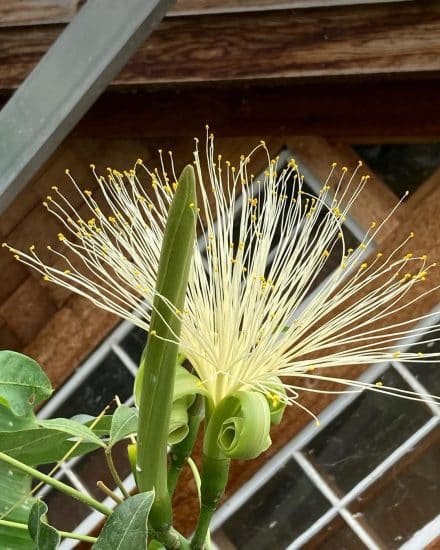
The Guiana Chestnut has shiny green leaves that sprout from the same center point, each with five to nine lance-shaped leaflets. And get this: it can grow to the impressive height of 60 feet outdoors! But don’t worry, it only gets up to 10 feet inside.
You’ve probably seen money trees with braided trunks. This doesn’t happen normally (we forgive you, Mother Nature), but when growers braid young, supple trunks before they harden.
Feng Shui holds that these braided trunks catch good luck and that the plant’s leaves snag good fortune and happiness.
If you buy a money tree with a braided trunk and you like the effect, you’ll have to keep braiding it as it grows. (You can wrap some strong string around the growing trunk tops to bind them in place for this purpose).
If you’re not a fan of the look, however, you can just stop, and the stalks will grow normally from that point on.
When grown outside, the money tree produces nuts that later turn brown and split, revealing seeds. The seeds can be ground into flour and are considered a delicacy in South America, where they’re used to make cocoa-like hot drinks.
Consensus in scientific studies is divided on whether the raw nuts are toxic, however, so keep that in mind if you do come across any.
Speaking of looks, Pachira aquatica sports a few, including the delightful variegated money tree. I mean… just look at it.
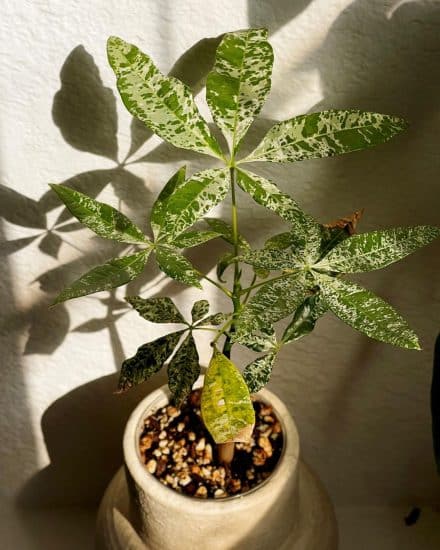
In the wild, the money tree produces large blooms with yellow petals that give way to flashy powderpuff flowers: white and yellow-orange stamens tipped with pink. Don’t expect nuts or flowers from the money tree indoors, though — it’s rare.
Okay, that’s most of the history we have for you. Now let’s get right into our Money tree plant care guide.
Light
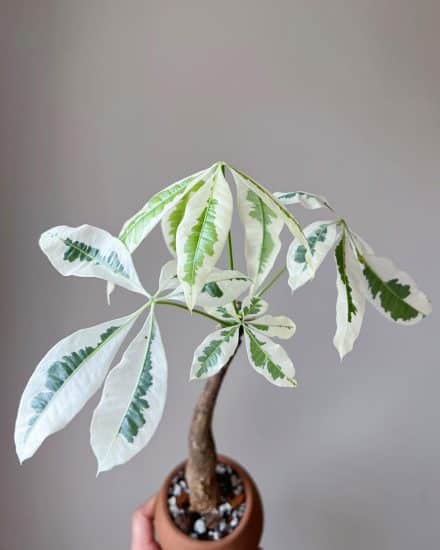
The money tree (Pachira aquatica) is accustomed to bright, filtered light like the kind it gets shining through the leaves of rainforests in its natural habitat. Bright indirect light is the best option, like the kind that comes through an east or north-facing window.
This plant also does well in lower light conditions — it’ll just grow more slowly.
If your money tree is getting too much direct sunlight, its leaves will curl at the tips, fade, and turn white. Too little sunlight? You’ll see leggy growth and only a few leaves as your plant reaches for the sun.
Rotate the plant every time you water it so that all sides can receive an equal amount of light. If natural light is scarce, you can use full-spectrum LED grow lights to supplement.
Water
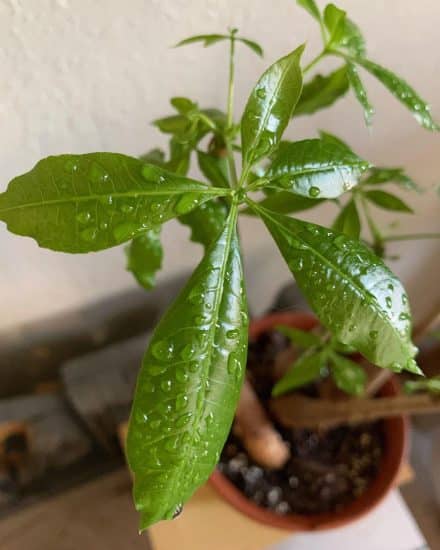
The question all nervous plant parents ask first: does my baby need water? Our answer with this plant is to let the soil tell you, and people might give you a funny look if they catch you talking to your plants.
Just ignore them.
Money tree plants prefer moist soil, but not sopping, so use the finger test to check your plant’s soil state. If it’s dry one or two inches down, time to water.
When you do water, you should really pour water until it drains from the bottom holes. Let the excess water drain completely. Use room-temperature water instead of cold water — you don’t want to shock your plant with an icy shower!
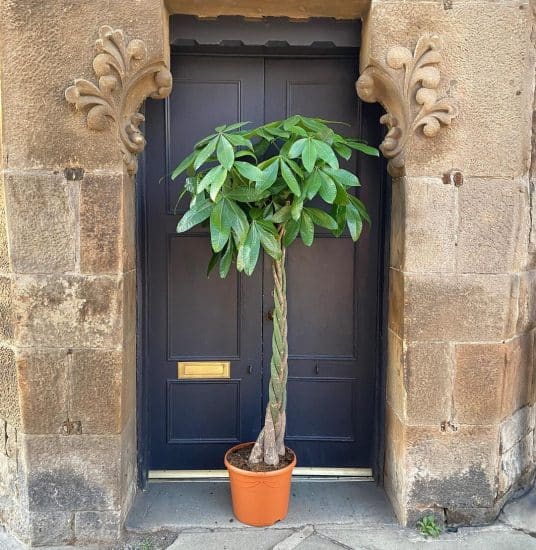
While we never recommend watering on a set schedule (since every plant, environment, and pot size is different), your money tree will typically need to be watered once every week or two. Water less in the winter months when it goes dormant.
Money tree watering tips:
- If using tap water, try to boil it first and let it cool to room temp, or sit out for 24 hours before watering — both help evaporate chlorine.
- Signs of over-watering: yellow leaves, soft stems, and a strong, musty odor coming from the soil (this could be rotting roots!).
- Brown, crispy leaves and droopy foliage might mean your plant isn’t getting enough water.
Temperature and humidity
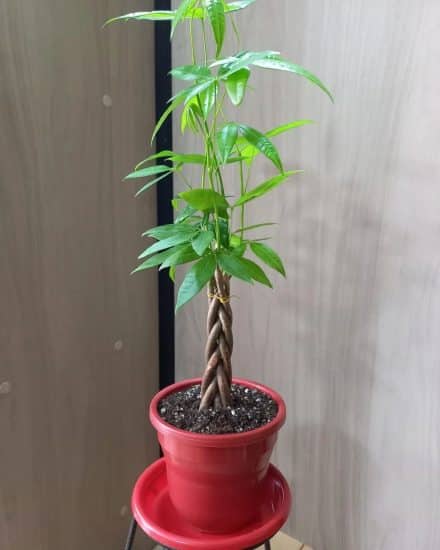
Money trees (Pachira aquatica) are tropical plants, so they love warmth and humidity. The ideal temperature range for this plant is what most houses and offices are probably set at, between 65-75°F.
Note that sudden fluctuations in temperature can cause stress and lead to leaf drop, so avoid placing your plant near drafty windows, doors or vents — I’m looking at you, air conditioners and radiators!
Have a droopy Pachira aquatica with browning or yellowing leaves falling off? It may be too cold. If the leaves wilt and turn brown or black in certain areas? Possibly too hot.
As you’d expect, the money tree is happiest in lots of humidity, ideally between 50-60%. Lack of humidity can lead to leaves curling and drying out, followed by yellowing or browning and shedding.
Money plant humidity tips:
- Set a humidifier nearby! This way, only the local environment gets more humid, instead of your whole house.
- Put your money tree on a pebble tray filled with water (just make sure the water stops before the pebble tops and your pot isn’t sitting in water).
- Group your plant with others that have similar humidity needs so they share moisture — this is called transpiration.
Soil and planting
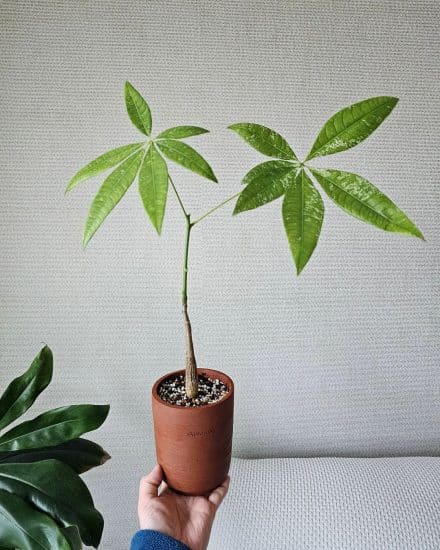
Your money tree will want a soil mix that drains well but still retains moisture. If you want to buy something at the store, look for a succulent or cactus potting mix with a coir or peat base.
If you want to get your hands a little dirty and make your own, though, we recommend this money tree potting mix:
- 40% peat moss
- 40% perlite
- 20% compost
Repotting
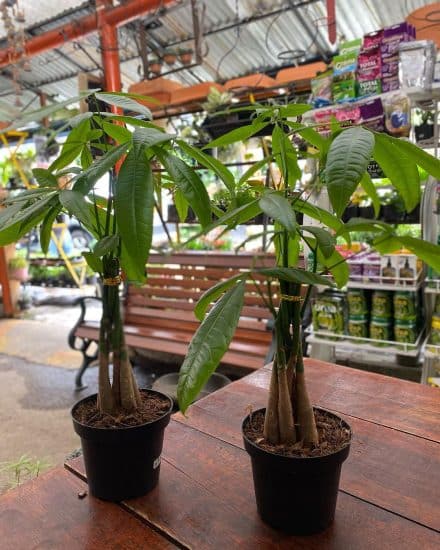
Repot your money tree every 2 – 3 years with fresh soil when its root system outgrows the pot. As with pruning, the best time to do this is in spring. Remove the money tree from its current pot and gently loosen up any tangled roots. Place it into a slightly larger pot with drainage holes (to avoid root rot).
Try not to disturb the roots too much during this process, as money trees are sensitive and may drop leaves when stressed. If this happens, it’s normal; wait for the plant to grow new leaves, and it should recover just fine.
Propagation guide
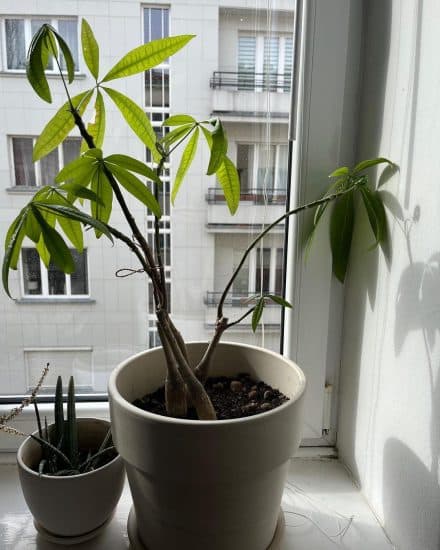
You have a few options here, namely seeds, stem cuttings, and air layering. You’re unlikely to get money tree seeds with an indoor plant, so we’ll focus on the other two methods.
Air layering is slightly more labor-intensive than stem cutting, but they both have great success rates.
Propagating money tree by stem cutting:
- Choose a healthy branch with new growth and snip off about a 6-inch section, making sure it’s got two or three leaf nodes.
- Remove any leaves from the bottom few inches of your stem cutting. You can optionally dip the cut end into a powdered rooting hormone, but it’s not necessary.
- Stick the branch into a small container of moist potting mix (see what we recommend in the “Soil and planting” section).
- Keep the soil moist, give the cutting lots of bright indirect sunlight, and cover it with a tented plastic bag or plastic liter bottle cut in half to keep humidity high.
- Be patient! It could take 6-8 weeks for roots to form, at which point you can treat the plant normally (remove the humidity cover and water normally).
Air layering is similar, except you dupe the plant into forming roots before you take a cutting.
Propagating money tree by air layering:
- Make a 1-inch cut on the underside of a healthy branch.
- Apply rooting powder.
- Wrap the cut surface with about damp moss (create a section about 3 inches wide). Tie clear plastic wrap around the moss ball with a rubber band.
- Keep the moss ball moist, adding water every few days.
- Once roots grow, then remove the moss ball, cut below it, and plant your new cutting in soil!
Common issues
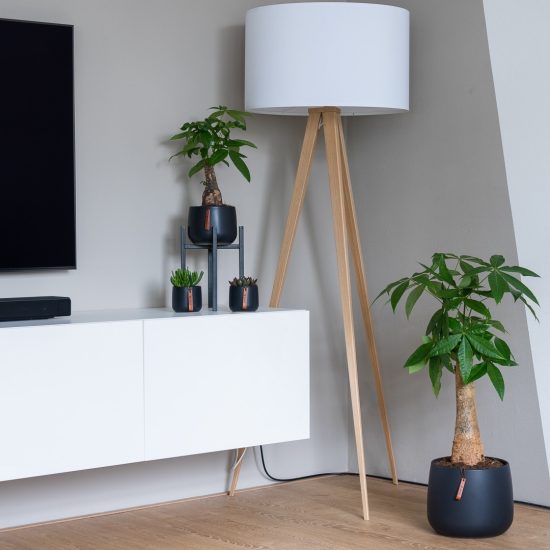
Even low-maintenance plants can experience some issues. Fortunately, they’re the same problems as almost every other plant, so they’ve got tried and true solutions.
Yellow leaves
Yellow leaves can be a sign of several issues. Do your Pachira aquatica’s leaves also look burnt or crispy in places? That’s a sign of too much direct light. Find a spot where it gets light that’s bright indirect light, or move it back from the source.
Is your soil constantly soggy? You’re overwatering, another possible source of yellowing. Haven’t fertilized in a while? Your money tree could be nutrient-deficient. Use a balanced houseplant fertilizer and watch those leaves go back to green.
Leaf drop
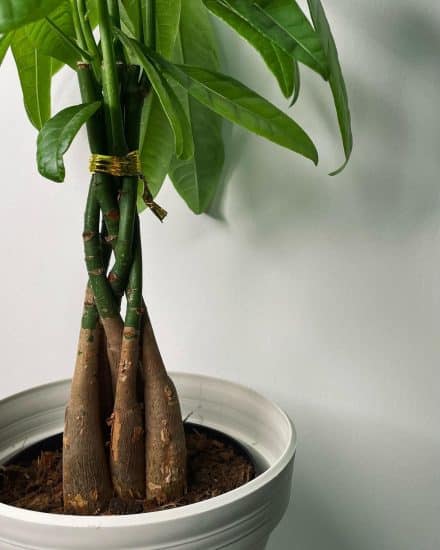
Money tree plants can drop leaves if they face sudden changes in temperature or humidity, so make sure it’s away from air conditioning and heating vents. If temps have been the same… leaf drop can also occur if you’re under or overwatering.
If the soil is waterlogged or bone dry, there’s your culprit. Overwatering = root rot = leaf drop, and an underwatered plant will shed its lower leaves to conserve water. Water thoroughly when the top inch of soil is dry, and make sure your pot has a drainage hole for excess water to flow through.
Finally, if your plant isn’t getting enough nutrients, it can get weak and drop leaves. Make sure to apply a balanced fertilizer at least monthly during the growing season.
Diseases and pests
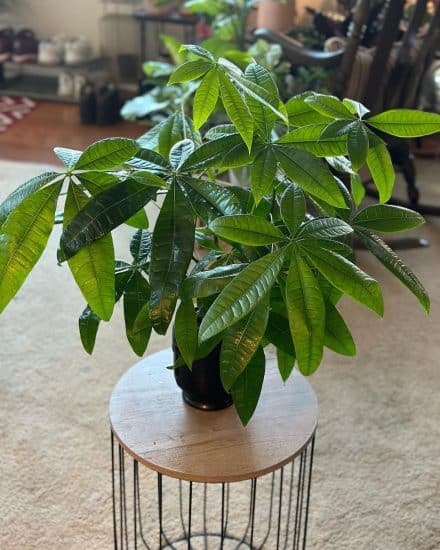
Similar to making sure your money is safe, you need to safeguard your Pachira aquatica from pests and diseases that could damage it, like fungus and aphids. So let’s assemble that vault!
Root Rot
This is a fungal disease caused by overwatering. Symptoms include yellowing leaves, soft and mushy stems, and a foul odor coming from the plant. If you suspect root rot, gently remove the plant from its pot and examine the roots.
Diseased roots look brown or black, slimy, and mushy, while healthy roots are white or light-colored.
The solution? Cut off the affected roots with sterilized scissors or shears until you reach healthy tissue, and repot the plant in fresh, well-draining soil. Only water when the top inch of soil is dry to the touch.
Pests
Spider mites, mealybugs, scale, and especially aphids might come to play. Aphids look like tiny green, red, yellow, or black specks measuring less than a quarter of an inch long. They suck the sap from your plant.
If they’re around, you might notice tiny holes or spots on leaves and also leaf yellowing, wilting, or curling. There might also be a sticky substance called honeydew.
Solution: Isolate your plant so the problem doesn’t spread. Spray diluted dish soap or neem oil all over the plant, which will suffocate the aphids.
Repeat the process once a week until the infestation has been resolved.
Conclusion
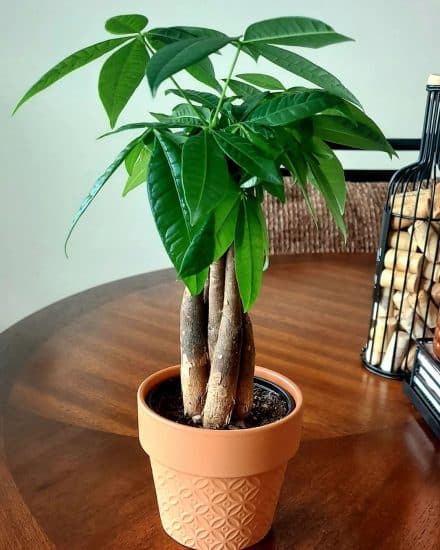
The money tree plant is a fantastic addition to any indoor garden, with its unique braided trunk, stunning leaves, and easy-care nature.
Whether you’re a seasoned gardener or just starting out, it’s sure to bring joy and prosperity to your space.
Money tree plant care summary:
- Keep your Money tree plant out of direct sunlight. If you don’t have a suitable spot, place it behind some plants that do like that harsh light or use a curtain. Even a few inches offset can help preserve its leaves.
- The money tree grows along river banks in its native habitat, so it doesn’t mind a moist potting mix. The trick is to let the soil dry a bit before watering again, and to really ensure your pot has at least a few drainage holes.
- You can use a liquid balanced fertilizer at half strength every month or so. Back off a bit during the winter months or whenever you notice growth slow down.
Send us some pics of where you put your money tree, and reach out with any questions on our socials — we’re happy to help!
FAQ
How do you take care of a Pachira aquatica?
Bright, indirect sunlight, and lots of humidity! These guys like it ideally at or above 50%. Try to keep it in the same temperature range of 65 to 75 degrees F as well, since they don’t like massive temp shifts.
Certain plants sold as P. aquatica are actually Pachira glabra (from Brazil), which look the same except for their thicker tree trunk. Don’t worry, they have the same care.
Do money tree plants do well indoors?
We certainly think so. Grown indoors, it doesn’t get as tall (and, fun fact, if it hits the ceiling, it’ll start to grow horizontally!) Plus, it’s said to bring good luck and good fortune. Who could resist?

